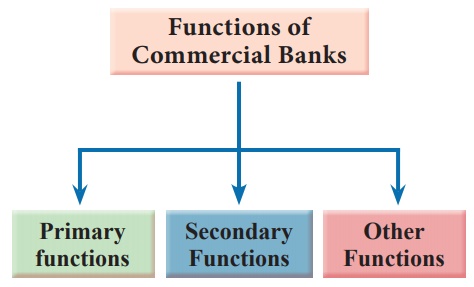Banking - Functions of Commercial Banks | 12th Economics : Chapter 6 : Banking
Chapter: 12th Economics : Chapter 6 : Banking
Functions of Commercial Banks
Functions of Commercial Banks:
Commercial banks are institutions that conduct business with
profit motive by accepting public deposits and lending loans for various
investment purposes.
The functions of commercial banks are broadly classified into
primary functions and secondary functions, which are shown in the picture


Functions of Commercial Banks
(a) Primary Functions:
1. Accepting Deposits
It implies that commercial banks are mainly dependent on public
deposits.
There are two types of deposits, which are discussed as follows
(i) Demand Deposits
It refers to deposits that can be withdrawn by individuals without
any prior notice to the bank. In other words, the owners of these deposits are
allowed to withdraw money anytime by writing a withdrawal slip or a cheque at
the bank counter or from ATM centres using debit card.
(ii) Time Deposits
It refers to deposits that are made for certain committed period
of time. Banks pay higher interest on time deposits. These deposits can be
withdrawn only after a specific time period by providing a written notice to
the bank.
2. Advancing Loans
It refers to granting loans to individuals and businesses.
Commercial banks grant loans in the form of overdraft, cash credit, and
discounting bills of exchange.
(b) Secondary Functions
The secondary functions can be classified under three heads,
namely, agency functions, general utility functions, and other functions.
1. Agency Functions: It implies that commercial banks act as
agents of customers by performing various functions.
(i) Collecting Cheques
Banks collect cheques and bills of exchange on the behalf of their
customers through clearing house facilities provided by the central bank.
(ii) Collecting Income
Commercial banks collect dividends, pension, salaries, rents, and
interests on investments on behalf of their customers. A credit voucher is sent
to customers for information when any income is collected by the bank.
(iii) Paying Expenses
Commercial banks make the payments of various obligations of
customers, such as telephone bills, insurance premium, school fees, and rents.
Similar to credit voucher, a debit voucher is sent to customers for information
when expenses are paid by the bank.
2. General Utility Functions: It implies that commercial banks provide
some utility services to customers by performing various functions.
(i) Providing Locker Facilities
Commercial banks provide locker facilities to its customers for
safe custody of jewellery, shares, debentures, and other valuable items. This
minimizes the risk of loss due to theft at homes. Banks are not responsible for
the items in the lockers.
(ii) Issuing Traveler’s Cheques
Banks issue traveler’s cheques to individuals for traveling
outside the country. Traveler’s cheques are the safe and easy way to protect
money while traveling.
(iii) Dealing in Foreign Exchange
Commercial banks help in providing foreign exchange to businessmen
dealing in exports and imports. However, commercial banks need to take the
permission of the Central Bank for dealing in foreign exchange.
3. Transferring Funds
It refers to transferring of funds from one bank to another. Funds
are transferred by means of draft, telephonic transfer, and electronic
transfer.
4. Letter of Credit
Commercial banks issue letters of credit to their customers to
certify their creditworthiness.
(i) Underwriting Securities
Commercial banks also undertake the task of underwriting
securities. As public has full faith in the creditworthiness of banks, public
do not hesitate in buying the securities underwritten by banks.
(ii) Electronic Banking
It includes services, such as debit cards, credit cards, and
Internet banking.
(c) Other Functions:
(i) Money Supply
It refers to one of the important functions of commercial banks
that help in increasing money supply. For instance, a bank lends ₹5 lakh to an
individual and opens a demand deposit in the name of that individual. Bank
makes a credit entry of ₹5 lakh in that account. This leads to creation of
demand deposits in that account. The point to be noted here is that there is no
payment in cash. Thus, without printing additional money, the supply of money
is increased.
(ii) Credit Creation
Credit Creation means the multiplication of loans and advances.
Commercial banks receive deposits from the public and use these
deposits to give loans. However, loans offered are many times more than the
deposits received by banks. This function of banks is known as ‘Credit Creation’.
(iii) Collection of Statistics:
Banks collect and publish statistics relating to trade, commerce
and industry. Hence, they advice customers and the public authorities on
financial matters.
Related Topics